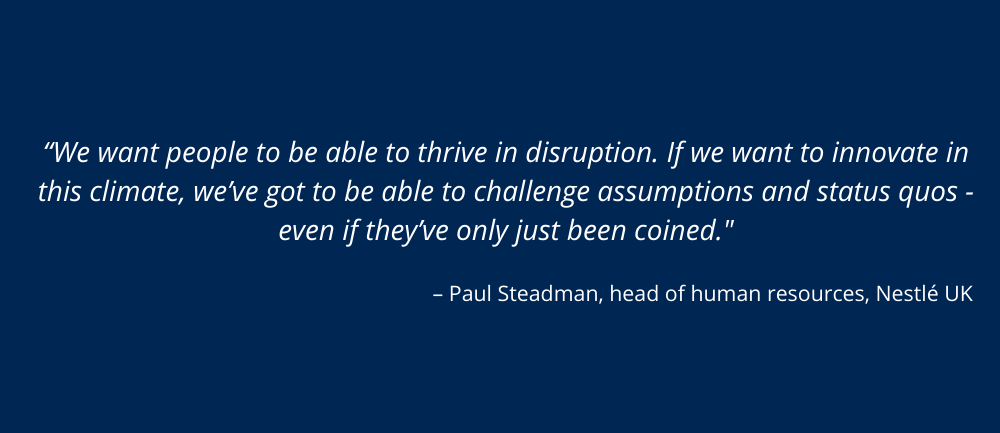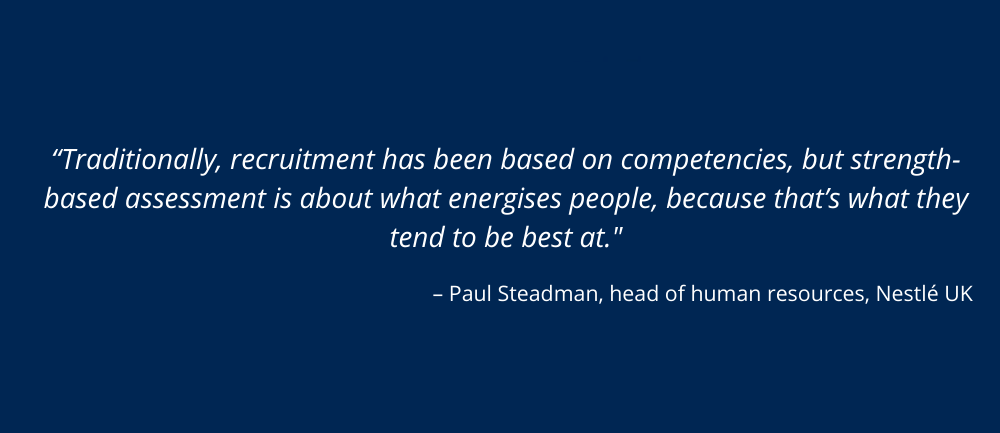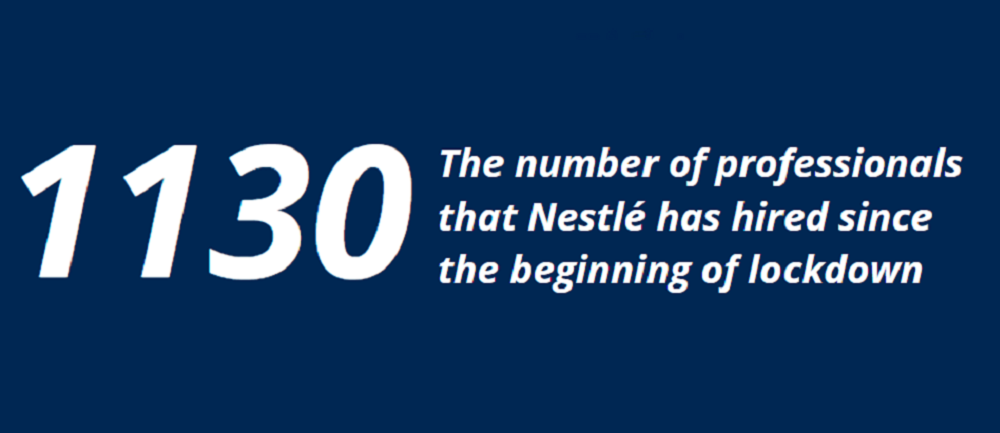-
Provided by

- Date published: Sep 29, 2021
- Categories
With organic sales growth of 7.7% in Q1 2021, Nestlé has continued to thrive during the pandemic. The food manufacturing giant has also continued to diversify, notably in the vitamins market.
However some of the biggest changes have been witnessed in the firm’s workforce. The pandemic has forced this traditionally ‘in-office’ company to embrace new ways of working and rethink the structure of its teams.
As Paul Steadman, head of human resources for Nestlé’s UK business units explains, this has obliged the company to demand new skills of its leaders – and adapt its approach to recruiting top talent.
“There’s a lot of talk about disruption,” says Paul Steadman. “But for us, disruptive environments can be quite intimidating.
“We want people to be able to thrive in disruption. If we want to innovate in this climate, we’ve got to be able to challenge assumptions and status quos – even if they’ve only just been coined. When we’re recruiting, these abilities are probably going to be more indicative of a person’s ability to succeed than any particular skill set that they come with.”
With this briefest of synopses, Paul encapsulates his company’s approach to hiring- and, in particular, leadership recruitment.
Major shift
Founded in the 1860s, Nestlé has over 350 factories worldwide. Like all manufacturing enterprises, it has traditionally been an ‘in-person’ organisation; in the UK, for example, activity has been driven by two key hubs, one near Gatwick airport and the other in York. However, the pandemic has forced a major rethink.
Although many employees were enjoying some form of flexible working before Covid-19, the pandemic has taken this into overdrive (in fact, the number of desks at some key sites is dropping around 50%). And while two-thirds of the workforce have continued to work in factories and distribution centres out of necessity, the remaining third has embraced some form of remote working.
Rather than try to stymie these inevitable changes, Paul and his colleagues have taken the opportunity to create a more enlightened approach to work. There are no fixed contracts governing the amount of time that colleagues will spend in the office. Staff are, in theory at least, free to work from anywhere in the UK, provided they are productive and continuously connected.
Additionally, the old idea of the office as a place of hierarchy and confinement has gone, forever. In Paul’s words, it is now a fulcrum for connection and learning; team members will come because of incentive, rather than obligation.

This new way of working is underpinned by technology. Hot-desking has been introduced, enabled by an app – which enables colleagues to book a desk before they even arrive at the office. Another app allows colleagues to order food in a way that is socially distanced and safe.
As time goes on, this move towards tech-enabled freedom will continue. “We will continually leverage app-based technology to allow people to take the decisions about where they will best be productive in real-time,” Paul says. “That’s definitely the way forward.”
However, the model is founded on vital human values: trust, communication and collaboration.
Everything is about securing consensus; for example, teams are now encouraged to agree when they are going to be in the office together, so they can connect and collaborate. Soft skills, based on compassion rather than control, are more important than ever.
“With more flexibility comes the need for more explicit commitment to each other,” Paul says. “The pandemic has demonstrated the importance of high levels of empathy, emotional intelligence, of being able to have high-quality two-way conversations.”

A new approach to leadership
With this new approach to working comes new requirements for leaders. The old, didactic way of working, based on instruction and enforcement, is no longer valid. Nestlé, like many other companies, requires new, softer skills from its leaders.
“Inclusive leadership” is the term Paul uses to describe the altered approach. “You can have a diverse team but if you’re not inclusive, if people don’t feel they can be their true selves at work, you’ll lose them.
“We have put a big focus on psychological safety. We want individuals to not only be themselves but also to express an opinion, to learn, to be free to make mistakes without fear of retribution. Everyone wants to do the job right but you won’t do that all the time.
“You have to feel you’ve got permission to contribute ideas, even if that idea is not the one people move forward with. And it’s the permission to challenge… to challenge leaders, challenge people with more seniority or experience, or simply people who are seen as more powerful influencers in the business. They may be your peers, they may not be more senior, but they may be recognised as more powerful.
“The leader is fundamental to this. We need leaders who talk less and listen more, and are attuned to the needs of others, as well as keeping a high focus on achieving goals. Being aware of your blind spots means you are better able to work on them and you can allow for that in your interactions with others.”
Hiring for change
To achieve this vision of leadership, based on empathy and the ability to hold open, honest dialogue with colleagues, Paul and his team have built a new, remote-friendly interview structure, using Microsoft Teams.
Typically each recruitment project consists of two to three interviews, although the precise number varies from one case to the next. What never changes, however, is the core structure of the interviews themselves.
Currently, the people leadership team have decided not to use psychometric tests (assessments that gauge a candidate’s suitability based on aptitude). Instead, Paul says, they gauge the suitability of candidates by asking specific questions about their previous experience, focusing on the way they have demonstrated the desired leadership characteristics.
“For example, I would ask when is the last time they arranged for some meaningful feedback from their teams about their impact as a leader, and ask them to be quite specific about the insights they received.
“I’m looking to find out not only their competency at a certain activity but also the areas they’re working on, based on that feedback. I’d also want to understand how they’ve adapted their leadership approach based on the circumstances and context of the teams they’re leading.
“The answers tell you a lot, because the questions are difficult to answer on your feet. You can’t just create compelling answers in the moment. You have to have thought about the question previously. So we can gauge levels of insight and impact quite authentically.
“We’re not looking for people to be perfect, because none of us are. We’re looking for a mindset. What’s their level of self-awareness? Do they understand the impact they have on others in their teams, and their peers? Are they aware of their development areas, and what are they doing about them? And what do they do to create an environment where people can speak up and thrive and where difference is embraced, rather than seen as a threat or a problem?”
Specifically, the interviewers zoom in on the candidate’s desire to gauge their own progress, and the impact they make on their people.
“We want to know how they track their leadership, and how they track and monitor it. We’re always keen to see how leaders quantify and track their own impact as leaders as well as their own impact on the bottom line. We’re looking to see whether leaders are keen to measure their impact as a leader.”

Attitude = aptitude
Through these incisive questions, Paul wants to gauge not so much his candidates’ ability, but rather the factors that drive them. Nestlé’s people leaders are devotees of strength-based assessments for their young academy entrants, an approach that uses a series of principles to gauge a candidate’s motivation to succeed.
“It’s an approach used by at least 30/40% of blue-chip companies,” Paul says. “Traditionally recruitment has been based on competencies, but strength-based assessment is about what energises people, because that’s what they tend to be best at. We use this approach with our academy entrants. It focuses on where people draw their positive energy and motivation from across a range of subjects and topics, rather than what they simply tolerate.”
Specifically, the interviewers zoom in on the candidate’s desire to gauge their own progress, and the impact they make on their people.
“We want to know how they track their leadership, and how they track and monitor it. We’re always keen to see how leaders quantify and track their own impact as leaders as well as their own impact on the bottom line. We’re looking to see whether leaders are keen to measure their impact as a leader.”

Retooling for change
In addition to revamping their approach to interviews, Paul and his team have devoted considerable time to training existing leaders, those who have been in the business at least nine months and have had time to make an impression on their teams. The training is designed to ensure each leader is attuned to the demands of empathetic, inclusive leadership, and it is based on feedback surveys carried out with individual team members.
Paul and his team aim to find out whether each employee can give their views without fear of retribution; whether they have their own personal development plan; whether they feel their skills are being fully utilised; and whether they have a clear sense of what the organisation is trying to do, and their role within it. This feedback is then channelled into personalised plans for each leader, delivered through a variety of channels.
“It’s partly webinars but there are analytics too, and we take the leaders through that,” Paul explains. “They drive the process themselves, seeking out the feedback from their teams using a suite of analytical tools. We also provide coaches from inside the business, to help them review the results and draw meaning from them.
“We want them to identify very simple but high-impact action plans on how they want to improve or change. If you ask people to do more than two or three things, by and large I think you’re asking too much.
“It’s about identifying the things that will make the biggest impact on their performance as leaders.”
A new, more diverse workforce
Eighteen months into the pandemic, Nestlé’s headline stats are impressive. A total of 1130 people have been recruited since the start of lockdown, with over 500 onboarded into the organisation virtually. Recruitment levels are now back up to their pre-Covid levels.
An equally encouraging factor is the diversity statistics; for instance, forty-five percent of Nestlé line managers in the UK and Ireland are now women. Nestlé has long been ahead of the game in this area – as far back as 2016, it was named the world’s most diverse food company – but now Paul and his team in the UK and Ireland are building on this progress.
“We’re using virtual connections to try and accelerate the recruitment of people from under-represented groups,” Paul says. “We’ve established links with external partners to understand the best routes in, the best channels to make ourselves visible to under-represented groups. Senior leaders are getting more involved in mentoring. And we’re partnering with schools.
“One example is a social enterprise programme called Wildhearts, which has links with nearly 40,000 pupils. They’re working with them on both a physical and a virtual basis, and we’ve reached just over 7,000 pupils this year. We’re not just aiming to educate them on Nestlé, but also help as part of the educational programme on sustainability, and help them on employability.”
As well as the human imperative behind the diversity agenda, Nestlé´s people leaders believe it makes business sense, too. The broader the talent pool, the greater their chance of finding the leaders they need. In Paul’s words, “a diverse workforce gives us our best chance of being successful.”
Despite all the progress, Paul says he and his team are still in a ‘test-and-learn’ phase: they are trialling various tactics to fine-tune their recruitment operation, and some will be phased out.
Nonetheless, Paul is delighted with the progress that has been made since the start of Covid-19, and believes it will have a long-term impact on Nestlé’s leadership profile.
“We’ve had to go fully digital, which has been quite a pivot. But we’ve been successful doing it. There’ve been some advantages – for example, we’ve been able to demonstrate our flexibility to candidates, working to their schedules as well as ours. And we feel that things like doing right-to-work checks online has really helped to speed the recruitment process up. We would like that to continue and are asking the government about that.
“We’ve put some really progressive policies in place too. For example, we’re able to arrange interviews outside traditional office hours, and we’re mindful that people’s access to digital platforms is not equal. So we’ve educated managers to be mindful about access. It might be about settings, it might be about interruptions, it might be about something as simple as the quality of their bandwidth. It’s about putting individuals at ease that if they have difficulties, we can and will work around them.
“Ultimately, we want to provide a high-quality candidate experience. The candidate is looking to us as much as we’re looking to them. We want to balance decision-making with pace, so they feel the process is moving forward and everything is fully visible.
“We feel we are achieving that. And we believe it will translate into the inclusive, diverse leadership we need.”

